Peter Kingston : Big Saturday
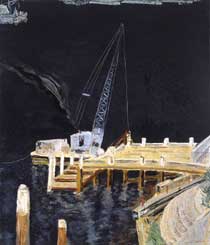
Peter Kingston
Big Saturday 1995
oil on canvas
Margaret Hannah Olley Art Trust 1997
Moving to Sydney's Lavender Bay in 1974, Kingston has always taken delight in bringing the harbour's grandeur to the fore in his drawings, prints and, more recently, paintings.
Exploring the harbour in his timber launch M.V. Anytime, which he purchased in 1997, Kingston makes direct studies which possess a raw beauty, and express the artist's deep regard for his marine environment.
Talking to biographer Gavin Wilson in 2003, Kingston noted:
When I moved to Lavender Bay in 1974, there were many boatsheds and slipways giving character to the place. It was a working bay full of interest...The boatsheds were timber and ramshackle and a joy to draw and paint. Now, there are no slipways. Only two boatsheds remain.
In Big Saturday Kingston's energetic handling of paint activates the deep blue expanse of canvas, traversed by the stretching reach of a crane, which is moored to the protruding jetty. He reminds us that our harbour city is imbued with a rich diversity of industrial as well as natural beauty.
Peter Kingston : Shag shed resumption, Walsh Bay


Peter Kingston
Shag shed resumption, Walsh Bay 1998-99
(detail below)
charcoal
Thea Proctor Memorial Fund 1999
Kingston has an enduring fascination for Sydney's maritime tradition, with its fleet of ferries gliding across the harbour, its wooden wharves and weathered docks. Having lived most of his life on the city's foreshore, Kingston captures in charcoal, oil and ink its transformation from a largely industrial working harbour to a playground for the rich and powerful.
When developers prepared to demolish Pier 6/7 at Walsh Bay in 1998, Kingston's outrage was manifest in a series of drawings, prints and paintings shown in the exhibition Hurry, last days in 1999. Aiming to capture the poignant beauty of these dilapidated structures before their demise, Kingston's drawings are precisely observed, imbued with all the energy and passion which distinguish his commitment to the preservation of Sydney's architectural heritage.
The finger wharves came from a period when people worshipped work. They were built of turpentine. You couldn't build them today; the forests have all gone. They stand for the uniqueness of this city, Sydney as a working port instead of this One.Tel generation of townhouses. They represented a simpler form of life.
Peter Kingston, 2001
Peter Kingston : Taronga Park - Sydney's Wonder Zoo
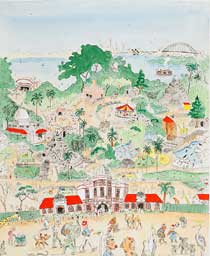
Peter Kingston
Taronga Park - Sydney's Wonder Zoo 1984
etching, hand coloured with watercolour
Purchased 1984
In 1984, Kingston embarked on a series of hand-coloured etchings inspired by the woodblock print Ohashi Bridge, sudden shower near Atake 1857 by Utagawa Hiroshige. This image depicts a group of people on a bridge caught in a sudden afternoon shower. It was also admired by Vincent van Gogh who painted Japanese bridge in the rain 1887 in response to this work. Kingston recalled in 2003:
They were very labour intensive... I found doing the etching frustrating. I was a bit annoyed that the scribe shot off at funny angles - I much preferred the fluid thing of the lino prints... I don't like metal on metal.
Despite the artist's initial difficulty with this medium, Kingston produced an enchanting collection of beautifully hand-coloured prints, which pay homage to the comic elements of everyday life in Sydney.
This is the Taronga Park of the 1950s. The elephant rides, the kids' train around the merry-go-round feature and the old Aquarium, a masterpiece in concrete. The ferry is the Lady Ferguson. Some license is evident with the Opera House and Centrepoint Tower being present. The park is shown in its unique setting on the harbour. The WWI digger and the pram make an appearance.
Peter Kingston, 1984
Peter Kingston : England -v- Australia chess set


Peter Kingston
England -v- Australia chess set 1976-78, reworked 1981
carved Oregon wood, enamel
Private collection
The chess set evolved from conversations with friends... all the pieces are popular characters I admire. I didn't set out to make a joke of the Royal Family, but they are ideal humorous figures.
Peter Kingston, 1981
Created between 1976 and 1978, then revised and updated in 1981 to commemorate the royal wedding of Prince Charles and Lady Diana Spencer, England -v- Australia chess set features a menagerie of characters representing the Colonial and the colonized. Cuddlepie and the corgi, the Queen Mother and the Opera Diva Dame Joan, each figure is carved meticulously from Oregon and lovingly hand painted in enamel.
The pieces cavort across a table flanked on four sides by the laughing, benevolent face of Sydney's Luna Park.
Throughout the ensuing decades, Kingston has continued to produce chess sets, creating New York chess set and Art lovers chess set in the 1980s, and more recently, in a tribute to his beloved funfair, he produced Luna Park chess set in 1995.
Peter Kingston : Shit a brick - Portrait of a shock jock
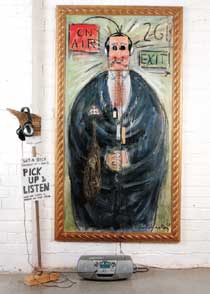
Peter Kingston
Shit a brick - Portrait of a shock jock 2002
mixed media
Private collection
Former speech writer and senior adviser to then Prime Minister Malcolm Fraser, and national rugby coach, Alan Jones is perhaps best known through his work as a morning radio host in Sydney. Often controversial, frequently confronting, Jones has accumulated numerous opponents to his brash and verbally attacking style of broadcasting. Kingston is no fan of Jones' flamboyant manner, which earned the artist's wrath when the broadcaster openly supported the development which led to the demolition of Piers 6/7 at Sydney's Walsh Bay.
An episode in 1988 - involving Jones being charged with indecency (later dropped with costs awarded to Jones) - was the inspiration for Shit a brick - Portrait of a shock jock, with Kingston commenting in an interview in 2005:
(It is) one of the best things I have ever done...It had to have a sting, so I turned his eyes into a cuckoo clock, showing that famous incident which happened in London ... the eyes become a London policeman chasing Alan Jones in an Australian tracksuit.
It also features Kingston's response to the radio personality's expletive-filled out-takes which were leaked to the media in 2002, a recording of some of these outbursts. The work was entered in the 2002 Archibald Prize, but its rejection earned it a place in that year's Salon de Refuse´s.
Martin Sharp : Mister Tambourine Man
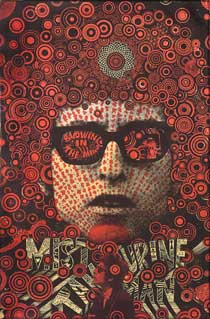
Martin Sharp
Mister Tambourine Man 1967
two-colour screenprint on gold reflective foil paper
Thea Proctor Memorial Fund 1970
Mister Tambourine Man was produced while Sharp was living in London and working as an illustrator for the underground magazine Oz. The image appeared on the cover of the seventh issue of the satirical journal, one of the most visually exciting publications of its time. Sharp also designed posters for musicians and bands, including Donovan, Cream and Jimmy Hendrix.
Sharp's image draws on the lyrics of the song by Bob Dylan, the subject of the poster. This image is synonymous with an emerging spirit of the 1960s. Emphasising the youth culture's focus on change and experimentation, Dylan's lyrics have been widely interpreted as recounting his early experiences with LSD. Experimentation with psychedelic drugs became a major component of 1960s counterculture, influencing philosophy, art, music and styles of dress. As one commentator noted: 'Sharp's living colour interpretation of LSD provided an instant "in" to psychedelia'.
This complex design is printed on gold foil paper, and features spiralling circular motifs which radiate from the singer's head. Sharp has related Mister Tambourine Man and other images from this period to his experience visiting the ancient Cambodian temple complex of Angkor in 1966. There he witnessed majestic fig trees sprouting from the multitude of smiling faces which grace the towers at the Bayon temple of Angkor Thom.
Martin Sharp : The astronaut is discovered by a dreaming pierrot

Martin Sharp
The astronaut is discovered by a dreaming pierrot 1970
two offset-lithographic prints on glass mirror
Thea Proctor Memorial Fund 1970
Upon his return to Sydney in 1970, Sharp presented a group of works he had exhibited in London's Sigi Krauss Gallery - the aptly named 'Artoons' - at the old Clune Galleries site in Sydney's Kings Cross, soon to become the Yellow House. Armed with a pair of scissors, a pot of glue, and books and magazines filled with images from every imaginable epoch and culture, Sharp delighted in finding new relationships through plundering images from the past. In Still life he merges Vincent van Gogh's golden-hued Sunflowers with the peroxided head of Andy Warhol's Marilyn Monroe. Another image morphs Goya's relining nude, La maja desnuda, with the seated figure of Whistler's mother, obscuring the matronly face, shoulders and skirt with her rosy flesh. 'A reminder that in every uncompromising old lady there are vestiges of a voluptuous young woman', Sharp observed.
In this wonderfully anachronistic collage, The astronaut is discovered by a dreaming pierrot, Sharp takes the iconic image of American astronaut Edwin 'Buzz' Aldrin on the first moon landing in 1969, and unifies it with Harlequin (1901), one of the most poignant images from Picasso's Blue period. Using cool tones to create an austere, sombre image, the painting reflects Picasso's intense feelings after the recent suicide of his friend Carlos Casagemas. The black stillness of space, where 'no-one can hear you scream', echoes the silent stare of the forlorn harlequin.
Martin Sharp : Cartoons
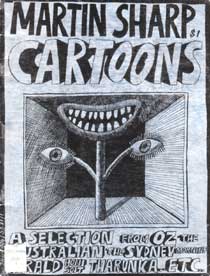
Martin Sharp
Martin Sharp cartoons: a selection from OZ, the Australian, Sydney Morning Herald, Honi Soit, Tharunka, etc.
Scripts Pty. Ltd, North Sydney 1966
Research Library and Archive, Art Gallery of New South Wales
This compilation of Martin Sharp's published cartoons and drawings was printed in 1966, the year he left Australia for London. It contains reproductions of many of Sharp's most sardonic works penned for newspapers and journals.
On April Fool's Day 1963, the first issue of OZ appeared, edited by Richard Neville, Richard Walsh, and Martin Sharp and filled with cartoons by Sharp, Garry Shead, Mick Glasheen, and Peter Kingston. The following year, the editors were charged under obscenity laws, found guilty under the Obscene and Indecent Publications Act, and sentenced to jail terms with hard labour. Fortunately for the defendants, this decision was quashed on appeal.
Martin Sharp : Catalog
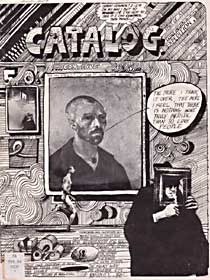
Martin Sharp
Catalog 1971
Reid Books, Sydney
launched April Fool's Day, 1971
at The Incredible shrinking exhibition
59 Macleay Street, Potts Point
Research Library and Archive, Art Gallery of New South Wales
I was exploring the idea of verbal collage and visual collage and each night I'd just sit down after working during the day getting the exhibition going, it was very like a digestive process. I'd just stick a few words down on a page and it'd grow and it'd reach a certain density, there's no sequence to read things in, no particular order. How many different worlds one could find, and so you start finding, building up a layer of different sentences and pictures and expression. And suddenly you'd start to find that there were strange connections between very disparate works ... It's connections like these that become very interesting. You realise that a lot of people reach similar conclusions from enormously different doorways which they've entered into...
I'm very interested in coincidence, and coincidence obviously happens all the time, so when a coincidence happens, it often belongs to a different, completely different world to the ordinary world we live in, it doesn't apply in that rationale at all.
Martin Sharp, interviewed by Albie Thoms, circa 1980
Martin Sharp : Miss Australia
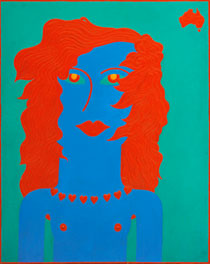
Martin Sharp
Miss Australia 1975
synthetic polymer paint on hardboard
Purchased 1977
In this painting, Sharp appropriated a drawing made by fourteen-year-old Cressida the daughter of his friend and newspaper columnist Ross Campbell painting directly over the original image. Campbell may have taken as her subject the newly crowned Miss Universe of 1972, Kerry Anne Wells, Australia's first winner of the contest. Now an established Sydney printmaker, Cressida Campbell works in the medium of unique, hand-coloured woodcuts.
With its broad expanse of bright, flat colour, and simple, two-dimensional rendering of an icon of American popular culture - the beauty pageant contestant - Sharp acknowledges both the techniques and themes which characterise works of the pop art movement. Devoid of any erotic overtones which might be expected in the portrayal of a beauty queen, Miss Australia shows Sharp at his satirical best, lampooning not only the notion of the artist as the lone creator, but also the very concept of the beauty contest in the age of feminism and sexual freedom.
Martin Sharp : Snow job

Martin Sharp
Snow job circa 1995
acrylic on plywood
Private collection
During the 1970s, the plight of Luna Park became one of Sharp's major preoccupations. Following the tragic Ghost Train fire of 1979, the future of the funfair remained uncertain. Together with Peter Kingston, Richard Liney and other sympathetic supporters, Sharp was instrumental in forming the Friends of Luna Park, a group which aimed to resurrect one of the most iconic monuments of Sydney's cultural heritage. The group organised public meetings and exhibitions to draw attention throughout the 1980s to the vulnerability of the site. Finally, in 1990, the Luna Park Reserve Trust was formed and major restoration of all the buildings took place in 1992.
Snow job depicts Luna Park's classic side-show attraction, the Laughing Clowns. A single face suffused by falling snowflakes is a poignant reminder of the threat the park continually faces, and the debt owed to the efforts of advocates such as Sharp and Kingston.
Martin Sharp : Abalone

Martin Sharp
Abalone 1990-2006
coloured pencil, ink, synthetic polymer paint on canvas
Private collection
In 1973, Sharp discovered a print which he believed was an unknown work by the Japanese Ukiyo-e master Katsushika Hokusai. The print, now lost, depicted one of Japan's legendary Ama abalone divers who, like her sisters, stick in hand, would hold her breath and dive up to 10 metres to prise the valuable molluscs from the rocks. The Ama were often depicted in erotic, eighteenth-century woodblock prints by Utamaro Kitagawa.
Working from a reproduction of the 'lost' Ama print and assisted by his long-standing collaborator Tim Lewis, in this greatly magnified version Sharp has painstakingly recorded the delicate line work and brilliant modulations of colour which distinguish the prints of Hokusai, an artist has he long admired.
Hokusai's most famous work, In the hollow of a wave off the coast at Kanagawa, from the series Thirty six views of Mount Fuji, had been adopted in one of Sharp's most recognisable images, The wave. This drawing featured R.B. Clark's comic-strip character, the quintessential Australian simpleton Boofhead, about to be overwhelmed by the approaching wall of water. It was penned by Sharp for The Australian newspaper, in response to Prime Minister Gough Whitlam's meeting with Chinese Premier Zhou Enlai in Beijing in 1971, the first Australian political leader to visit China.
|